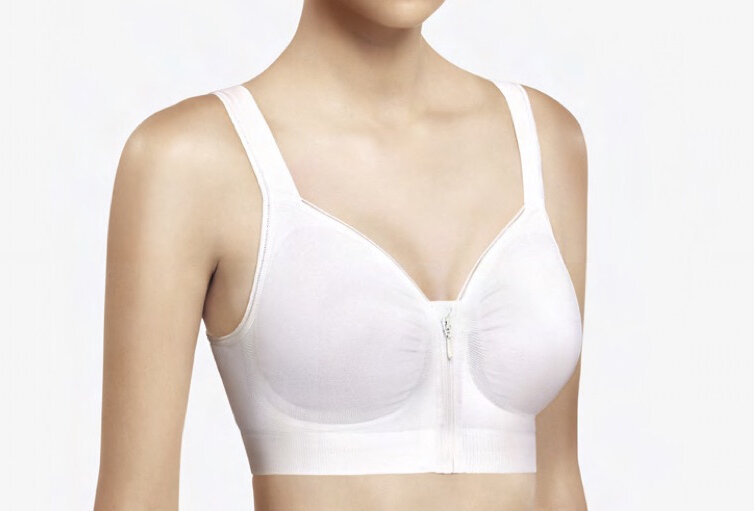ALL ABOUT SURGICAL GARMENTS
WRITTEN BY FULVIO URSO-BAIARDA CO-FOUNDER AND PLASTIC SURGEON AT ETERNO 360, ETON, BERKSHIRE
If you are considering any kind of cosmetic procedure then it is very likely you will soon be introduced to the world of postoperative garments, whether it is a bra, corset, thigh or arm compression, or some imaginative combination of each. And you have my sympathies, because it can be a somewhat confusing world for the uninitiated. Hopefully we can demystify things a little bit here.
Why do i need to use surgical garments post surgery?
Because they really help make your recovery quicker and less painful. It’s all about something called ‘dead space’. Dead space is a space that has been opened up in the body and not filled with anything. Anytime we dissect somewhere surgically, the route we follow creates potential dead space. For example, during a tummy tuck we need to dissect under your abdominal wall all the way up to your ribcage. After closure that whole area of the front of your tummy then becomes dead space (the same happens with a breast augmentation, liposuction, arm or thigh reduction, body lift). Now as they say, nature hates a void, and your body tends to fill dead space until it can’t fill it any more: with a mixture of blood and tissue fluid. That fluid then keeps the dead space open, which allows more fluid accumulation, and so on. The result can be prolonged, painful swelling.
Cue surgical garments. These essentially compress down your surgical dead space, reducing the potential volume of fluid that can leak into it and allowing the two raw surfaces to heal back together. Once they’re completely healed you can take off the garment without reaccumulation of fluid. It usually takes a few weeks for that healing to happen, provided the surfaces are kept in contact during that time. But if you remove the garment too early and fluid gets in there, the two surfaces can’t touch, so they can’t stick back down. Just one night off from your garment could easily set you back an extra few weeks.
Closing dead space is not the only function of postoperative garments. Garments also reduce general tissue swelling (which is not quite the same as fluid accumulation in dead space), reduce blood loss, and can usefully restrict movement, for instance of breast implants.
What’s special about them?
So what’s the difference between a postoperative garment and sportswear, for example? Let’s be clear, postoperative garments are often rather expensive. The difference in cost between a “bra” and a “surgical bra” is a bit like that between a “cake” and a “wedding cake”. How so? At the end of the day they’re roughly the same thing, right?
Well, not quite. Just like a wedding cake isn’t really the same as a supermarket trifle, surgical garments are specially made to be comfortable when you are at your most sensitive – with fresh bruises, fresh scars, possibly oozy bits, lumpy dressings and a more-or-less accurately predicted postoperative size of the bit of the body in question – after all, the usual reason for having cosmetic surgery is to make bits of you bigger or smaller. Proper surgical garments are designed with such considerations in mind. The seams tend to be on the outside, the material is breathable and sometimes impregnated with soothing or antibacterial materials, and they should have enough stretch to deal with the uncertainty around how big they actually need to be, yet enough resistance to compress what they are supposed to.
They may also fasten in unusual or versatile ways. For example, a bra which does up as usual at the back is not much use to theatre staff faced with a patient who is unconscious and lying on their back with drips connected to their hands. As a result, surgical bras are usually front-fastening with detachable shoulder straps, allowing them to be slipped underneath the sleeping patient and reconstituted from the front. The same applies to compression short/tummy combos. Have you noticed how floppy a new baby is when trying to put them into a baby grow, and how easy that doesn’t make it? Now imagine the baby weighs 60 kilos and the baby grow is slightly too tight. We need all the help we can get, and the various cunningly placed zips, fasteners and Velcro straps can really come in handy.
Ok, garments sound great
I’m glad I’ve talked you round. But I must admit, they’re not an unadulterated joy to live with. Sizing can be a real point of difficulty, mostly down to the fact that you are measured before surgery and (newsflash) the bit you measured is generally a different size afterwards. I’ve included links to some size guides below to give you a few pointers.
Of course, garments can be difficult to keep clean too. They are meant to stay on most of the time and may therefore make use of (somewhat inadequate) holes for your various bodily functions. Ladies, take it from me: if you are going to need to pee around a garment, invest in one of these (https://tinyurl.com/ybbhzvzd). You’re welcome. Top tip number 2: buy two of any garment. Inevitably it will get gammy somehow or another, and you shouldn’t remove it off for as long as the duration of a laundry cycle.
What garment should I buy?
I’ve used most brands over the years and all have their pros and cons. I have no vested interest (no pun intended) in any of these. In the end it comes down to personal preference, and if possible you should try to handle the different garments beforehand – ask your surgeon or clinic if they can help you do so, because you certainly don’t want to buy them all! In many cases your clinic will supply your garment so you won’t have to worry about this bit at all, but in case you do here are the main players. Sizing instructions are also available via the links.
The Fitting Service (https://www.thefittingservice.com/) gives advice across several brands (and receive a 10% discount at checkout with the code 1BNZSD68GVSM)
Macom (www.macom-medical.com) (and receive 15% at checkout with the discount code ETERNO)
Voe (www.voe.es/en) (distributed in the UK by www.recovapostsurgery.com)
Eurosurgical (www.esshop.co.uk)
Marena (www.marenagroup.com/) (also available through Amazon)
Lipoelastic (www.lipoelastic.co.uk) (and receive 15% at checkout with the discount code ETERNO)
Finally, Marks & Spencer (M&S, www.marksandspencer.com) do a postoperative range of bras which work out much cheaper than the specialist brands. Patients occasionally turn up with these and they are fine, but I would recommend one of the front-fastening options for immediately postop (of which there are only two in the range).
Good luck, and feel free to get in touch with any questions or comments.

